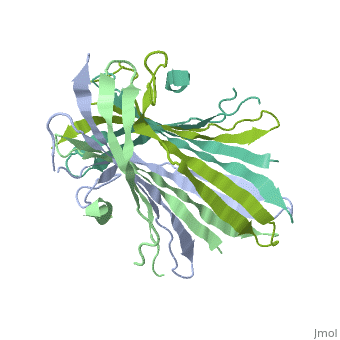User:Vinícius M. Neto/Sandbox 1
From Proteopedia
(Difference between revisions)
| Line 7: | Line 7: | ||
== Relevance == | == Relevance == | ||
| - | Silk fibers from Bombyx mori have been utilized by mankind since ancient times due to its remarkable mechanical properties and comfort when woven into fabrics, its earliest record being around 2.700 BC. It is thermally comfortable, elastic, strong and soft and that is why it is highly sought after as a luxury fabric for garments. It is also biocompatible, making it even applicable as a medical biomaterial for sutures or scaffolds. | + | Silk fibers from Bombyx mori (silkworm), have been utilized by mankind since ancient times due to its remarkable mechanical properties and comfort when woven into fabrics, its earliest record being around 2.700 BC. It is thermally comfortable, elastic, strong and soft and that is reasons why it is highly sought after as a luxury fabric for garments. It is also biocompatible, making it even applicable as a medical biomaterial for sutures or , drug delivery systems ands scaffolds, where silk plays a vital role in tissue regeneration. . |
| - | Bombyx mori silkworms naturally use their silk to construct a cocoon at the end of the final stage of larval development before cocoon formation, before they undergo metamorphosis into a moth. During the natural spinning process, the silkworm extrudes the silk dope (a water-soluble liquid crystalline state containing up to 30%wt/vol fibroin in water) from its spinnerets into the external environment. This process involves mechanical shearing, stretching, and water evaporation. The delicate gland conditions (silk dope acidification, concentration changes of metal ions, and water content reduction) are crucial for the proper folding of fibroin into micelles and then liquid crystals. | ||
| + | Fibroins are remarkable structural proteins found across various organisms, primarily silkworms, spiders, and other arthropods, where they play critical roles in survival and ecological interactions. Bombyx mori silkworms naturally use their silk to construct a cocoon at the end of the final stage of larval development before cocoon formation, before they undergo metamorphosis into a moth. During the natural spinning process, the silkworm extrudes the silk dope (,a water-soluble liquid crystalline state containing up to 30%wt/vol fibroin in water), from its spinnerets into the external environment. This process involves mechanical shearing, stretching, and water evaporation. The delicate gland conditions (silk dope acidification, concentration changes of metal ions, and water content reduction) are crucial for the proper folding of fibroin into micelles and then liquid crystals. | ||
| + | |||
| + | |||
| + | Fibroins are fibrous structural proteins composed of multiple subunits that assemble into high-strength materials like silk and byssal threads. The exact subunits vary by organism, but they generally include core fibroin proteins, glycoproteins, and regulatory elements. Also some fibroins have heavy chains while other much lighter chains. Disulfide bonds play an essential role in binding glycoproteins to he heavy and light chains. | ||
| + | |||
| + | |||
| + | Silk fibroin transitions between two key structural states: Silk I, the soluble pre-spun form stored in silk glands, consists of type II β-turns that prevent premature crystallization, while Silk II, the spun fiber's insoluble crystalline form, is dominated by mechanically robust antiparallel β-sheets. The N-terminal domain of fibroin plays a critical regulatory role—its pH-sensitive structure (rich in acidic residues) helps maintain Silk I's solubility in the gland but triggers the shift to Silk II during spinning by undergoing conformational changes that nucleate β-sheet formation. This pH-driven mechanism, combined with shear forces and dehydration, ensures the precise, irreversible transition from Silk I's storage form to Silk II's functional fiber, optimizing silk's strength and biological utility. | ||
== Function == | == Function == | ||
Revision as of 20:59, 18 June 2025
Your Heading Here (maybe something like 'Structure')
| |||||||||||
References
- ↑ Hanson, R. M., Prilusky, J., Renjian, Z., Nakane, T. and Sussman, J. L. (2013), JSmol and the Next-Generation Web-Based Representation of 3D Molecular Structure as Applied to Proteopedia. Isr. J. Chem., 53:207-216. doi:http://dx.doi.org/10.1002/ijch.201300024
- ↑ Herraez A. Biomolecules in the computer: Jmol to the rescue. Biochem Mol Biol Educ. 2006 Jul;34(4):255-61. doi: 10.1002/bmb.2006.494034042644. PMID:21638687 doi:10.1002/bmb.2006.494034042644

